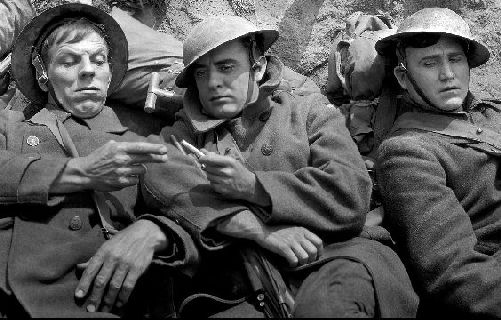The Big Parade (1925) 
“The epic of the American doughboy!”

Director: King Vidor
Cast: John Gilbert, Renée Adorée, Hobart Bosworth
Synopsis: The idle son of a rich businessman joins the army when the U.S.A. enters World War One. He is sent to France, where he becomes friends with two working-class soldiers.
Tired of making movies that never seemed to run for longer than a week, 31-year-old director King Vidor voiced his complaints to MGM boy-wonder Irving Thalberg. He wanted to make a big, serious movie about the Great War. Thalberg, enthused by Vidor’s ideas, tried to purchase the rights to the stage hit ‘What Price Glory?’ but when he discovered another studio had already bought the rights, he hired one of its authors, WWI vet Laurence Stalling, to write a screenplay. The Big Parade was the result, earning the studio a staggering $22 million at a time when, following the finance-draining escapades of the Ben-Hur shoot, its future looked uncertain. When they realised how much moolah the picture was likely to make, MGM conned Vidor into relinquishing his contractual right to 20per cent of the net profit in return for a modest one-off payment. Such is life in Hollywood.
The story follows the exploits of three squaddies from different social backgrounds as they join the war in France. Slim (Karl Dane) is a construction worker, Bull (Tom O’Brien), a bartender, and Jimmy (John Gilbert) is a rich layabout, who has no intention of signing up for service until he witnesses a toe-tapping parade celebrating America’s entry into the war and gets swept up by all the exuberance. Jimmy’s girlfriend Justyn (Claire Adams) is thrilled, as is his stern father (Hobart Bosworth), who had previously despaired of his son’s wastrel ways, but his mother (Claire Macdowell) isn’t so enthusiastic.
The plot does little to explore the differences in these three recruits from opposing ends of the social strata, choosing instead to resort to light comedy as they get involved in a series of semi-comical scrapes. In terms of comical impact, most of these incidents are lukewarm at best, although one scene, in which Jimmy wanders around with a barrel over his head, works pretty well. It’s while wearing this barrel that he bumps into the fetching mademoiselle Melisande (Renee Adoree), with whom he quickly establishes a relationship, despite having a sweetheart waiting for him at home.
The burgeoning romance is temporarily halted by the call to arms, and the movie’s tone alters accordingly. The rush to the front, during which Jimmy and Melisande frantically search for one another, provides a dramatic highpoint which is enhanced by the following battle scene. The battle begins slowly – a slow walk through a sun-dappled forest before building to a crescendo in the more familiar muddy wastelands of war. What takes place during this battle is the stuff of parody these days, but it was no doubt fresh back then, and the movie’s phenomenal success may partially be attributed to the fact that it touched upon situations and incidents familiar to a large proportion of the audience, who had endured similar experiences less than a decade before.
Still considered the most financially successful movie of the silent era, The Big Parade, while still a remarkably accomplished piece of filmmaking, looks just a little creaky today. The pacing is erratic – and a lot slower than many audiences today would be comfortable with – but the anti-war sentiment, and the personal nature of the story still comes through strongly (Stallings, like Jimmy, lost a leg during the war).
(Reviewed 3rd July 2012)
httpv://www.youtube.com/watch?v=0uQdhBEfgkY
